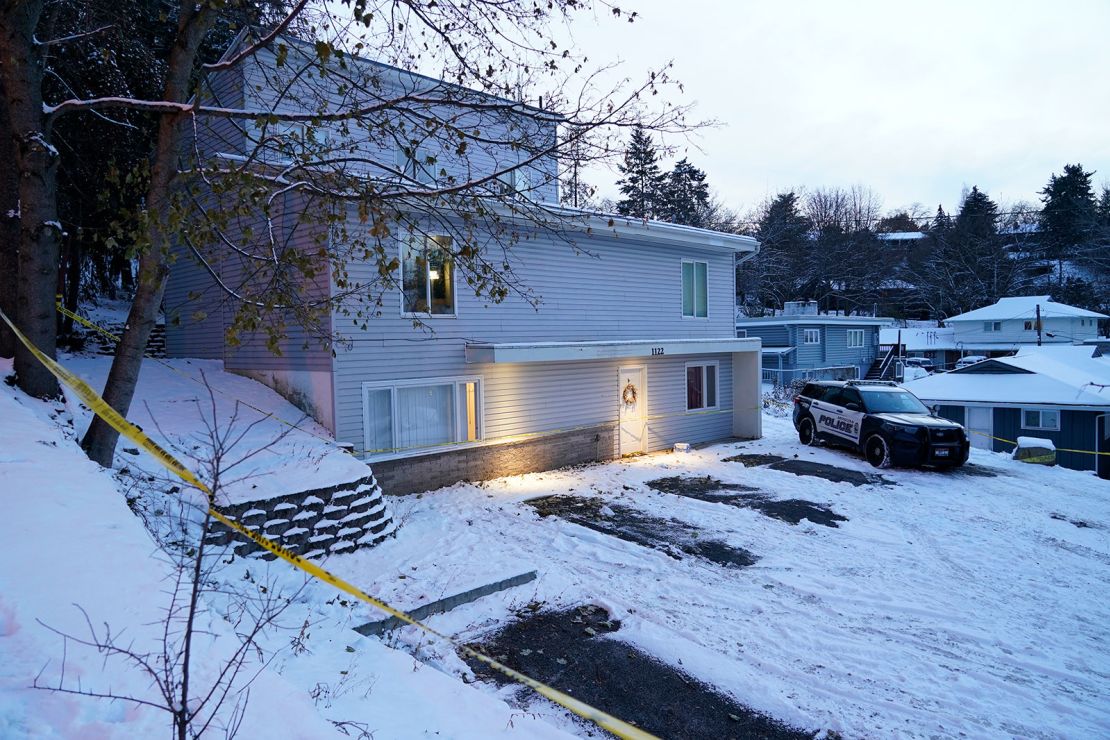It was around 4 a.m. when University of Idaho student Dylan Mortensen said she was woken up by strange noises in her off-campus house.
She and her roommates had returned earlier from a typical Saturday night out in the college town when the sounds spurred a night of terror with a flurry of panicked texts and unanswered calls.
Three of Mortensen’s roommates and a boyfriend of one of the students would be found dead inside the house the next morning on November 13, 2022 — stabbed to death with no signs of a break-in.
DNA from the brutal slayings ultimately led to the arrest of 30-year-old criminology graduate student Bryan Kohberger. A not guilty plea has been entered on his behalf for the murders of Kaylee Goncalves, Madison Mogen, Xana Kernodle and Ethan Chapin.
Mortensen and another roommate, Bethany Funke, are the only two from inside the three-story Moscow, Idaho, house to survive.
Now, as Kohberger’s trial nears over two years later, the personal accounts and phone activity from the two surviving roommates provide more insight into what they say happened in the early morning hours of the murders as the defense attempts to discredit their testimony and call into question why they waited eight hours to call 911.
Court documents paint a picture of a night filled with odd sounds, unknown voices, panicked texts, unanswered calls and a shadowy figure in the hallway – all in the setting of a college town that hadn’t experienced a murder since 2015.
Not much is known about Mortensen and Funke, whose phone activity and personal accounts were revealed in court documents in the last several weeks. A wide-ranging gag order in the case prevents them from speaking publicly about their experience.
While the defense tries to show through their filings the two surviving roommates spent an inordinate amount of time on their phones before calling 911 – an attempt to call into question their timeline of events – a psychological expert says a multitude of factors could’ve played into this delay.
“When we are faced with trauma or fear, we all have different response systems, and there’s no one right response system,” said Elizabeth Cauffman, a psychological science professor at the University of California, Irvine.
While a complete picture of that morning has yet to form, the surviving roommates’ accounts and documentation shed light on what the housemates endured in a case shrouded with mystery and speculation.
Here’s how the night of the murders unfolded, according to court documents:
Roommates return home after a Saturday night out
After a busy Saturday night out, the roommates returned to the three-story, six-bedroom Moscow house in the early hours of November 13, 2022.
Kernodle and her boyfriend had been at a party at a frat house. Mogen and Goncalves were at a local bar then stopped at a food truck for late-night carbonara before making their way back home.
The roommates began arriving back home and heading to their rooms in the early morning hours, with Kernodle briefly leaving her room to grab a DoorDash order around 4 a.m., Mortensen and Funke told police, according to court documents.
The third floor housed Goncalves and her dog in one room and Mogen in another. Kernodle and Chapin were on the second floor, where Mortensen also had a bedroom, according to the affidavit.
Funke was the lone occupant of the first floor, where the front door was.
Roommate on second floor says she heard crying
Around 4 a.m., Mortensen, who shared the second floor with Kernodle, woke up to noises upstairs, telling police she thought Goncalves was playing with her dog on the third floor.
Shortly after, Mortensen said she thought she heard Goncalves say “something to the effect of ‘there’s someone here,’” the affidavit says. She looked out her bedroom door but didn’t see anything.
Then she heard crying coming from the direction of Kernodle’s room and looked outside once more, she told investigators.
From above, she heard a male voice that wasn’t Chapin’s say something like “It’s ok, I’m going to help you,” according to court documents. It’s not clear where the male’s voice came from.
Mortensen heard crying again and opened the door, this time seeing “a figure clad in black clothing” with a mask covering their mouth and nose walking toward her, the affidavit said.
She froze, Mortensen said, and the person walked past her and to a sliding back glass door, according to the affidavit. She then locked herself in her room.
She didn’t recognize the man. Mortensen later described him in grand jury testimony as being around her height “or a few inches taller,” having a “lean build” and wearing all black, according to court documents. She also noted in the same testimony she saw one bushy eyebrow. She told police during several interviews after the murders her memory was a bit blurry since she had just woken up and may still have been drunk, according to the documents.
Around 4:17 a.m., a security camera less than 50 feet from Kernodle’s bedroom wall picked up distorted audio of what sounded like voices, or a whimper followed by a loud thud, according to the affidavit. A dog can also be heard barking.
‘No one is answering … I’m freaking out’
At 4:20 a.m., Mortensen started frantically calling her roommates – Kernodle, Goncalves, a brief 41-second call with Funke, then Kernodle again. She called Mogen again before texting Funke saying, “No one is answering.”
Funke had also tried calling Mogen, Kernodle and Chapin during that time.
“Kaylee,” Mortensen texted Goncalves. “What’s going on”
The text message remained unanswered. Investigators believe the four roommates were killed sometime between 4 a.m. and 4:25 a.m.
“Ya dude wtf,” Funke replied, with Mortensen describing someone in “like ski mask almost.”
Mortensen and Funke, identified by their initials in the court documents, continued texting back and forth about the man in the hall, typos growing more frequent as their panic rose.






